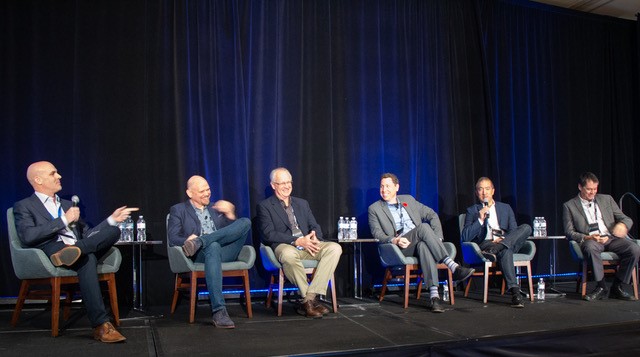
TORONTO – Like most others worldwide, Canadians' TV viewing habits seem in constant flux. They're taking to streaming and on-demand viewing, driven by the adoption of Amazon Prime, Netflix, Crave TV, and other services, and are watching on more than television sets. An expert panel at the Canadian ISP Summit took a look at this changing landscape and discussed what the future may hold for ISPs and traditional TV providers.
Moderator Brad Fisher, CRO of Distributel, was joined by panelists Doug Edwards, executive chairman and founder of Zone TV, Kerry Travilla, VP of technology at MobiTV, John Pomeroy, GM – Canada at Blonder Tongue Laboratories, Kan Inaba, senior director, IPTV at Rogers Communications, and Peter Vandenengel, president and founder of Netperian (they are pictured left to right).
Despite changes in viewer preferences, Fisher noted Canadians still love the 10-foot experience in the living room. “The popularity of app-based viewing also lends itself well to supporting that 10-foot experience in the home," he said, "and we want to understand how carriers through TV operators can evolve to support that in the midst of a change.”
The 10-foot experience isn't going away, Edwards agreed. "We've been working with pay TV operators to figure out, as the world changes and folks are looking to say, 'I've got so many other places (for) my subscription dollars', how pay TV operators stay relevant in that space," he said, "and where we place the pretty big bet is truly around the curation and the programming of that linear experience."
He thinks that pay TV operators have the opportunity to bring streaming services into a "walled garden" where customers can access a supportable experience. If something, anything, goes wrong, they can pick up the phone and call one place.
"I will definitely say that the future of TV is the next generation of IP, which is streaming delivery," Travilla said, but he believes it will evolve from physical set top boxes to a more app-based approach, effectively taking the box's functionality and embedding it in software that will run on any device.
“Really, we should call it bundle busting." – Kerry Travilla, MobiTV
Cord cutting, he said, is the wrong way to characterize the phenomenon. "People are not cutting the cord, if the cord is the broadband connection to the home," he said. "It's like turning your electricity off or turning your plumbing off, because you have a leaky faucet. What they really mean is they're bundle cutting. It's the force taking of a huge, expensive 300 channel bundle; IP provides the democracy to say ‘no, I'm going to better budget where I spend my entertainment dollars.’ And IP… is the enabler of that. But really, we should call it bundle busting."
"An operator has to avoid just being a source of content," added Vandenengel, "because they'll lose against Netflix and Amazon and everyone else."
In fact, Edwards said, Comcast is positioning its X1 platform (branded by Rogers here as Ignite TV, Shaw as BlueSky and Videotron as Helix) as being more of a merchandising, connected home platform than just a TV platform.
"It's really giving people one place to shop," he said. "So you're seeing this trend of operators playing in the video entertainment space becoming more about marketplace than anything I've seen, and I think you're right. It's not about just buying content rights from studios and networks. They can be table stakes for sure, but it's how do I bring all of the other ancillary services into one place that's easily discovered and personalized."
"That," said Travilla, "is why it's sometimes good to have it on a piece of equipment that is managed," he added noting that maybe set tops or in-home gateways will still have their place.
With its X1 implementation, Rogers is converging the traditional linear TV ecosystem with over-the-top (OTT), Inaba noted.
"We've rolled out Netflix and YouTube, and we have a number of other partners that are waiting in the wings," he said. "What we're trying to do on our side simplify the experience for customers. That's why we have the voice search side of things. You can actually pull up your YouTube content through voice search, Netflix content through voice search, as well as your linear TV, VOD, cloud DVR content, all through that that voice interface, all on common hardware for these customers. That's the direction where we're trying to take things going forward and obviously, trying to embrace a lot of the OTT partners that are in the marketplace that are basically providing streaming content."
A big opportunity for operators, Edwards suggested, is in niche content that helps differentiate them from generic services – content customers can't easily or cheaply find elsewhere, curated and assembled so they can access it in one place. Pomeroy agreed, adding that with the amount of regionalization in Canada, there's a huge opportunity for operators to provide content to smaller markets that can't be found on Netflix or Apple.
"You'll never get them head-on," agreed Vandenengel.
However, Inaba wondered, how can operators cost-effectively onboard all of the OTT content since there is, he pointed out, significant overhead involved in onboarding each new provider, figuring out how to bring its content into a discovery engine, and setting up payment models. It's a challenge for all operators.
That said Edwards explained there's a 10-times increase in usage and subscription uptake for OTT brands when it can be found in a program guide on a set top box, making it easily accessible, even though it's accessed through an app that on the box. Curation, and bringing content together so people can find it is the real key.
"It's entertainment," Fisher concluded. "People don't want to work too hard for it."



